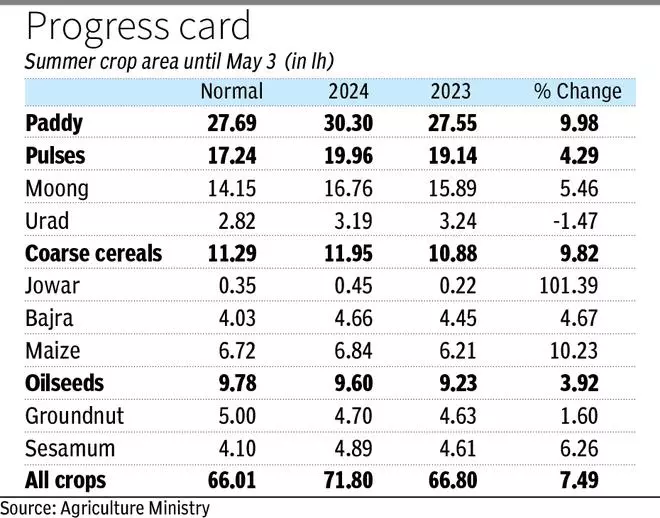The area under summer crops has increased to 71.80 lakh hectares (lh) as of Friday, which is 7.5 per cent more than 66.80 lh reported in the year-ago period as the zaid season is coming to an end. The total normal area (last 5-year average) under zaid crops, grown before kharif sowing and after rabi harvest, is estimated at 66.01 lh in a season.

Sowing under summer paddy has increased to 30.30 lh until May 3, which is 10 per cent more than 27.55 lh reported in the year-ago period.
Also read: Tin prices may rule higher this year on concerns over supplies
Summer pulses acreage has gone up 4.3 per cent to 19.96 lh from 19.14 lh as higher coverage of moong has been reported this year. Moong sowing is up at 16.76 lh against 15.89 lh in the year-ago period and urad coverage has dropped to 3.19 lh from 3.24 lh. Key growers of summer pulses are Madhya Pradesh, Bihar, Odisha, Tamil Nadu, Uttar Pradesh and Gujarat.
Nutri-cereals coverage up
Oilseeds acreage was reported at 9.60 lh, up by 4 per cent from 9.23 lh. Groundnut acreage reached 4.70 lh and sesamum at 4.89 lh both rising from 4.63 lh and 4.61 lh, respectively from the year-ago period. Sunflower acreage reached 33,387 hectares against 32,318 hectares year-ago.
Acreage of summer-grown nutri cereals and maize is up 10 per cent at 11.95 lh from 10.88 lh as higher coverage of jowar, bajra and maize has been reported this year. Jowar sowing is up at 45,000 hectares against 22,000 hectares in the year-ago period while bajra acreage was reported 5 per cent higher at 4.66 lh from 4.45 lh. Maize acreage too was up 10 per cent at 6.84 lh from 6.21 lh.
Also read: Spices exporters forum allay concerns over ethylene oxide usage
Meanwhile, the cumulative rainfall in pre-monsoon season since March 1 is 15 per cent below normal at 63 mm against the normal 74.3 mm on pan-India basis until May 3. While the Central India has received 71 per cent higher precipitation than its long period average (LPA) between March 1 and May 3, the north-west region has 3 per cent surplus over normal rains. But, the south peninsula region is 70 per cent deficient and east and north-east India 28 per cent lower than average precipitation, India Meteorological Department data show.





